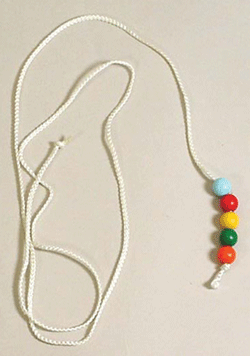Vision Therapy Tools, Part 1
 My last blog post provided a basic definition and overview of Vision Therapy. As promised, in this and future posts I will introduce you to some of the tools used in our Vision Therapy clinic.
My last blog post provided a basic definition and overview of Vision Therapy. As promised, in this and future posts I will introduce you to some of the tools used in our Vision Therapy clinic.
Some of the most effective and commonly used Vision Therapy tools are also the simplest in terms of design. We’ll start with the Brock String, which is basically a long beaded string. It is used to treat convergence insufficiency and other anomalies of binocular vision. A sensory and neuromuscular disorder, convergence insufficiency is the inability of the eyes to turn toward each other, or sustain convergence. Convergence, or the simultaneous inward movement of both eyes, is necessary to keep close-up objects, such as words on a page, crisply in focus. That’s why children with convergence insufficiency struggle with schoolwork.
In addition to developing convergence skills, the Brock String disrupts suppression, which occurs when the brain ignores the images of one eye. The Brock String helps condition the brain to process images from both eyes.
During therapy, one end of the Brock String is held on the tip of the nose while the other is tied to a fixed point. The beads are spaced out at various distances. The patient is asked to focus on one of the beads, while noting the visual input of each eye and sensation of convergence. Special lenses and prisms may be used for more advanced therapeutic work.
Though simple in design, the Brock String provides patients with a great deal of visual feedback while teaching them how to aim their eyes together correctly for varying distances in space and experience the “tug” they should feel on both sides of the bridge of their nose as muscles contract to pull the eyes inward. Kinesthetic awareness, or “body awareness,” is an important first step in teaching patients to control eye coordination.
To see a demonstration of Brock String training and the visual feedback it provides, click here. (This video is also useful for Vision Therapy patients who need a refresher on proper use of the Brock String.)
We use a variety of other simple but effective tools to work on muscle movement and control, including accommodative charts (sometimes called near-far charts), anti-suppressive charts and saccades charts (to help control rapid eye movements).
Accommodative flexibility is the ability of the eyes to change focus back and forth from near objects to far objects — an important skill in the classroom, on the playing field and behind the wheel of a car.
In the coming weeks, I’ll introduce you to some other common vision therapy tools, as well as some sophisticated computerized hardware and software used in our clinic.
Dr. Jeff Pinkerton
I care for you.
Comments are closed.

[…] Posted in Uncategorized | Leave a comment Tweet I introduced you in September to some simple yet effective tools used in our Vision Therapy clinic. In this follow-up, I will cover some other common tools and […]
I have been introduced to the Brock therapy, I see the benefits working right away, but the side effects of the therapy can be unbearable such as the fatigue. Have you ever had patients benefit from the therapy but yet experience problems before getting better?
From Dr. Pinkerton: Every last one of them! They experience fatigue, which goes away over time, just as the pain of physical therapy is bad at first until you get better. Give us an update on your progress!